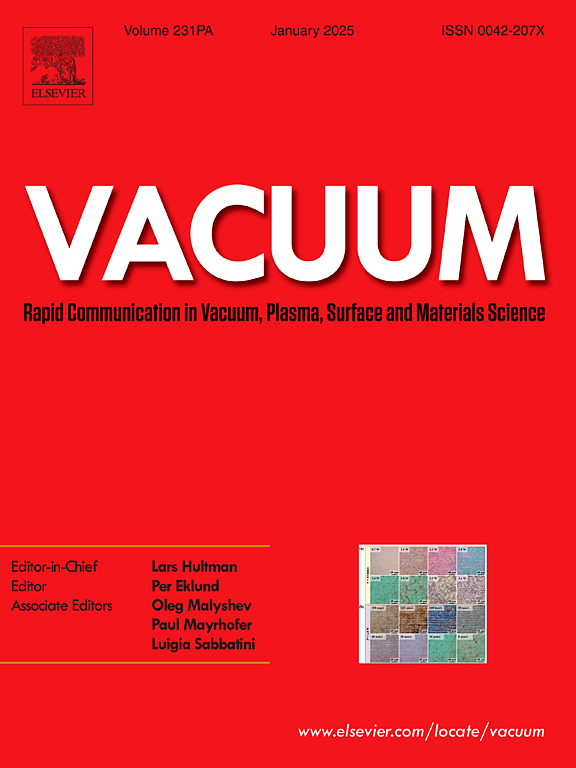HiPIMS沉积梯度调制期TiSiN/AlCrN多层涂层的力学和摩擦学性能
IF 3.8
2区 材料科学
Q2 MATERIALS SCIENCE, MULTIDISCIPLINARY
引用次数: 0
摘要
具有多层或梯度结构的硬质氮化物涂层在机械加工领域得到了广泛的应用,其调制周期(Λ)在其中起着至关重要的作用。本研究采用高能脉冲磁控溅射(HiPIMS)法制备了4种不同调制周期和厚度梯度变化(3.6 ~ 12.3 nm)的TiSiN/AlCrN多层涂层。研究了Λ的变化对涂层组织、力学性能和耐磨性的影响。涂层主要由fcc纳米晶和少量非晶SiNx组成。较小的Λ和梯度设计导致层间界面不清晰和相互扩散,在Λ = 4.6 nm处显示出相干界面。调制周期的梯度变化显著改善了涂层的力学性能。调制周期先增大后减小(G3梯度结构)的涂层具有最高的硬度(38.4 GPa)、结合强度(68.2 N)、H/E∗(0.084)和H3/E∗2 (0.380 GPa)。由于具有较高的硬度和润滑相,G3具有最低的磨损率(5 × 10−15 m3N−1m−1)和较低的摩擦系数(0.34)。本文章由计算机程序翻译,如有差异,请以英文原文为准。
TiSiN/AlCrN multilayer coatings with gradient modulation period deposited by HiPIMS: Mechanical and tribological properties
Hard nitride coatings with multilayer or gradient structures have been widely used in the field of machining, and their modulation period (Λ) plays a crucial role in it. In this study, high energy impulse magnetron sputtering (HiPIMS) was used to prepare four kinds of TiSiN/AlCrN multilayer coatings with different modulation periods and gradient variations in thickness (3.6–12.3 nm). The influence of Λ variation on the microstructure, mechanical properties, and wear resistance of coatings was studied. The coatings were mainly composed of fcc nanocrystals and a small amount of amorphous SiNx. The smaller Λ and gradient design result in unclear interlayer interfaces and mutual diffusion, displaying a coherent interface at Λ = 4.6 nm. The gradient variation of modulation period significantly improves the mechanical properties of the coating. The coating with an increasing and then decreasing modulation period (G3 gradient structure) exhibits the best mechanical properties, with the highest hardness (38.4 GPa), bonding strength (68.2 N), H/E∗ (0.084), and H3/E∗2 (0.380 GPa). Due to its high hardness and the presence of lubricating phases, G3 has the lowest wear rate (5 × 10−15 m3N−1m−1) and a lower friction coefficient (0.34).
求助全文
通过发布文献求助,成功后即可免费获取论文全文。
去求助
来源期刊

Vacuum
工程技术-材料科学:综合
CiteScore
6.80
自引率
17.50%
发文量
0
审稿时长
34 days
期刊介绍:
Vacuum is an international rapid publications journal with a focus on short communication. All papers are peer-reviewed, with the review process for short communication geared towards very fast turnaround times. The journal also published full research papers, thematic issues and selected papers from leading conferences.
A report in Vacuum should represent a major advance in an area that involves a controlled environment at pressures of one atmosphere or below.
The scope of the journal includes:
1. Vacuum; original developments in vacuum pumping and instrumentation, vacuum measurement, vacuum gas dynamics, gas-surface interactions, surface treatment for UHV applications and low outgassing, vacuum melting, sintering, and vacuum metrology. Technology and solutions for large-scale facilities (e.g., particle accelerators and fusion devices). New instrumentation ( e.g., detectors and electron microscopes).
2. Plasma science; advances in PVD, CVD, plasma-assisted CVD, ion sources, deposition processes and analysis.
3. Surface science; surface engineering, surface chemistry, surface analysis, crystal growth, ion-surface interactions and etching, nanometer-scale processing, surface modification.
4. Materials science; novel functional or structural materials. Metals, ceramics, and polymers. Experiments, simulations, and modelling for understanding structure-property relationships. Thin films and coatings. Nanostructures and ion implantation.
 求助内容:
求助内容: 应助结果提醒方式:
应助结果提醒方式:


